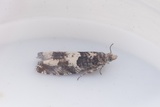Epinotia demarniana (Fischer von Röslerstamm, 1840) Species
Last modified: Nov. 23, 2025, 7:15 p.m.
A widely distributed and fairly common species throughout Belgium.
Details
- Classification
- Family: Tortricidae > Subfamily: Olethreutinae > Tribus: Eucosmini > Genus: Epinotia > Species: Epinotia demarniana
- Vernacular names
- Berkenoogbladroller (NL), Birch Bell (EN), Birkenkätzchen-Wickler (DE)
- First mention in Belgium
- Sauveur J. 1863. Notes entomologiques. — Annales de la Société entomologique belge 7: 75–85. On page 84.
- Status
-
Native
Distribution
Imago
Wingspan 13–15 mm. Distinguished from similar species by its ochreous-white head and palps. On the dorsum it has two white patches. The central one with one or two fine strigulae. The tornal one with a characteristically shaped anterior border. The brown wing may be ochreous marked beyond one half and there are pale paired costal strigulae.
Bionomics
The larva lives in a catkin and hibernates and pupates in a cocoon amongst leaf-litter on the ground.
They rest high in the trees during daytime. Towards dusk, the adults fly high above the trees and later come to light.
Flight periods
The adults usually fly from mid-May towards mid-July, occasionally later.
Observed on
- Host plant (genera):
- Betula
The larva feeds mainly on Betula. Not sure but perhaps also on Alnus glutinosa and Salix caprea.
Habitat
It inhabits woodland, heathland, fens and bogs.







